
Diet Research Data:Effects of High Fat Diet 32, Low Fat Diet, and Other Commercial High-Fat Diet on Male C57BL/6J Mice
Related CLEA Japan product: High Fat Diet 32

For the animal, please click here↓![]() : https://www.clea-japan.com/en/products/general_diet/item_d0080
: https://www.clea-japan.com/en/products/general_diet/item_d0080
Inquiry:
If you have any question, please feel free to contact us from here.
1.Objective
This study aimed to compare the effects of a low-fat diet (LFD, 10 kcal% fat, 366 kcal/100g), a high-fat diet (High Fat Diet 32, or HFD32, 57 kcal% fat, 508 kcal/100g), and other commercial high-fat diet for obesity and diabetes research (60 kcal% fat, 520 kcal/100g) on C57BL/6J mice.
2.Materials and Methods
(1)Experimental Site
The experiment was conducted in the mouse breeding facility (conventional) of Nippon Compound Feed Manufacturing Co., Ltd. (currently Feed One Co., Ltd.) Central Research Laboratory.
(2)Diets
- Low Fat Diet (LFD): Crude fat content 4.0%, Fat kcal% 10.2%, soluble non-nitrogenous substance content 64.3%, NFE kcal% 68.8%
- High Fat Diet 32 (HFD32): Crude fat content 32.0%, Fat kcal% 56.7%, soluble non-nitrogenous substance content 29.4%, NFE kcal% 23.2%
- Other commercial high-fat diet: Crude fat content 33.1%, Fat kcal% 58.1%, soluble non-nitrogenous substance content 30.8%, NFE kcal% 24.2%
(3)Animals
Male C57BL/6JJcl mice were used (10 mice per group, 30 mice in total).
(4)Housing Conditions
- Temperature and humidity: Temperature = 21-25°C, Humidity = 40-60%
- Lighting: 12-hour light/12-hour dark cycle (lights on 9:00 AM - 9:00 PM)
- Cages: Individually housed in polycarbonate cages with sterilized wood chip bedding
- Diet: Ad libitum
- Drinking water: Ad libitum tap water
(5)Experimental Procedure
C57BL/6J mice were introduced at 4 weeks of age and acclimatized for 1 week (fed CE-2). Mice were then randomly divided into 3 groups based on body weight, blood glucose levels, and blood glucose levels from an oral glucose tolerance test at 5 weeks of age. The experimental diets were fed from 5 weeks of age to 20 weeks of age. Statistical analysis was performed using Tukey's test.
3.Results
The results are described below.
1.Body Weight
Changes in body weight
Body weight was measured weekly. Data points and vertical bars in the figure represent the mean ± standard error. Statistical analysis was performed between groups at each time point, and different symbols indicate significant differences (p < 0.05).
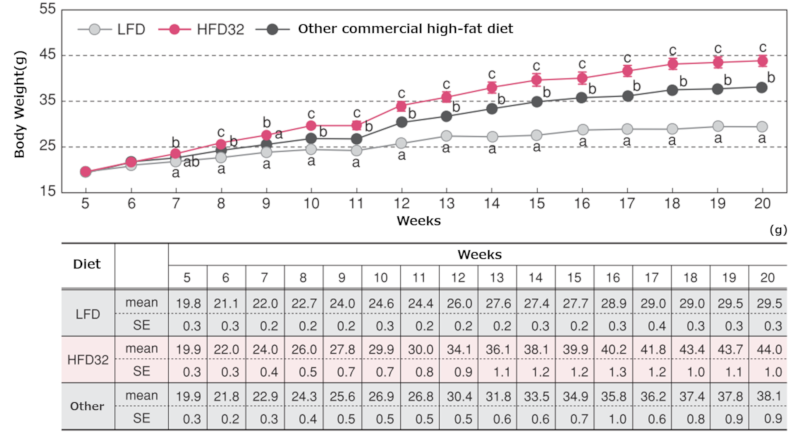
2.Food and Water Intake
Changes in food intake
Food intake represents the average daily intake per animal at each time point. Data points and vertical bars in the figure represent the mean ± standard error. Statistical analysis was performed between groups at each time point, and different symbols indicate significant differences (p < 0.05).

Changes in water intake
Water intake represents the average daily intake per animal at each time point. Data points and vertical bars in the figure represent the mean ± standard error. Statistical analysis was performed between groups at each time point, and different symbols indicate significant differences (p < 0.05).

3.Random Blood Glucose Levels
Changes in random blood glucose levels
Blood was collected from the tail vein every 3 weeks at 1 PM. Whole blood was measured using a whole blood glucose meter (GlucoTest PROR, Sanwa Kagaku Kenkyusho Co., Ltd.). Vertical bars in the figure represent the mean ± standard error. Statistical analysis was performed between groups at each time point, and different symbols indicate significant differences (p < 0.05).

4.Fasting Blood Glucose Levels
Changes in fasting blood glucose levels
Fasting blood glucose levels were measured at 5, 15, and 20 weeks of age (before starting the experimental diet, 10 weeks, and 15 weeks, respectively). After an overnight fast (20 hours), blood was collected from the tail vein, and whole blood was measured using a whole blood glucose meter (GlucoTest PROR, Sanwa Kagaku Kenkyusho Co., Ltd.). Vertical bars in the figure represent the mean ± standard error. Statistical analysis was performed between groups at each time point, and different symbols indicate significant differences (p < 0.05).
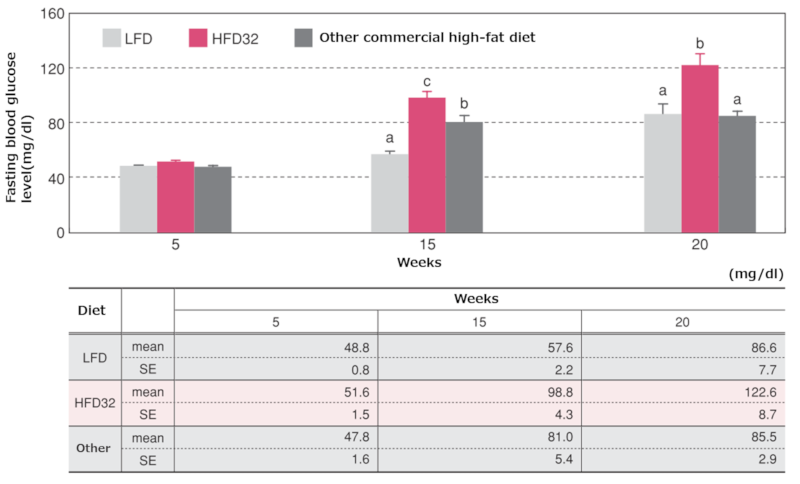
5.Oral Glucose Tolerance Test
Oral glucose tolerance test results at each time point
The oral glucose tolerance test was conducted at 5, 15, and 20 weeks of age (before starting the experimental diet, 10 weeks, and 15 weeks, respectively). After an overnight fast (20 hours), mice were orally administered a glucose solution (2 g/kg body weight) using a gavage needle. Blood was collected from the tail vein before administration (0 min) and 30, 60, and 120 min after administration. Whole blood was measured using a whole blood glucose meter (GlucoTest PROR, Sanwa Kagaku Kenkyusho Co., Ltd.). Data points and vertical bars in the figure represent the mean ± standard error. Statistical analysis was performed between groups at each time point, and different symbols indicate significant differences (p < 0.05).


6.Insulin Tolerance Test
Insulin tolerance test results at each time point
The insulin tolerance test was conducted at 10 and 20 weeks of age (5 and 15 weeks after starting the experimental diet, respectively). An insulin solution (0.5 IU/kg body weight) was administered intraperitoneally, and blood was collected from the tail vein before administration (0 min) and 20, 40, 60, 80, and 120 min after administration. Whole blood was measured using a whole blood glucose meter (GlucoTest PROR, Sanwa Kagaku Kenkyusho Co., Ltd.). Data points and vertical bars in the figure represent the mean ± standard error. Statistical analysis was performed between groups at each time point, and different symbols indicate significant differences (p < 0.05).
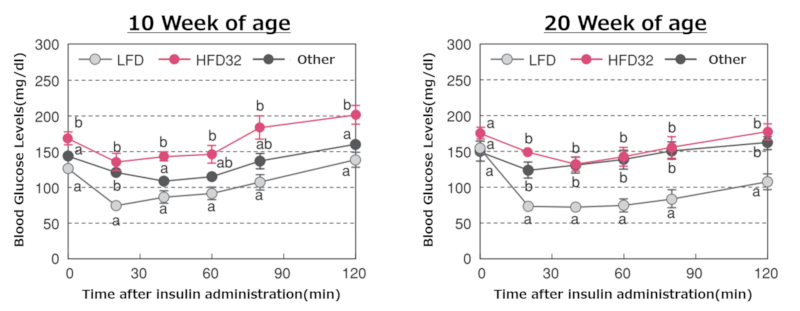

7.Blood Analysis at Biopsy
Blood lipid analysis
At 20 weeks of age (n=10 per group), blood was collected after a 20-hour fast under isoflurane anesthesia via the posterior vena cava. Serum levels of total cholesterol (T-Cho), HDL-cholesterol (HDL-Cho), triglycerides (TG), and non-esterified fatty acids (NEFA) were analyzed. Data points and vertical bars in the figure represent the mean ± standard error. Statistical analysis was performed between groups, and different symbols indicate significant differences (p < 0.05).
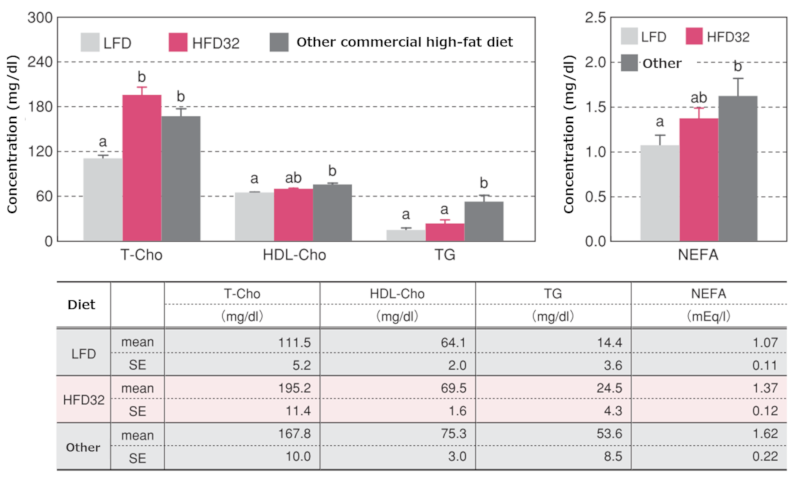
Fasting insulin levels
At 20 weeks of age (n=10 per group), blood was collected after a 20-hour fast under isoflurane anesthesia via the posterior vena cava. Plasma insulin levels were measured using an insulin measurement kit (microplate EIA sandwich method) from Morinaga Seikagaku Kenkyusho Co., Ltd. Data points and vertical bars in the figure represent the mean ± standard error. Statistical analysis was performed between groups, and different symbols indicate significant differences (p < 0.05).

8.Weights of Major Organs at Biopsy
Major organ weights
At 20 weeks of age (n=5 per group), organs were removed after a 20-hour fast under isoflurane anesthesia and weighed. Data points and vertical bars in the figure represent the mean ± standard error. Statistical analysis was performed between groups, and different symbols indicate significant differences (p < 0.05).

Adipose tissue weight
At 20 weeks of age (n=5 per group), adipose tissue weight was measured after a 20-hour fast under isoflurane anesthesia. Data points and vertical bars in the figure represent the mean ± standard error. Statistical analysis was performed between groups, and different symbols indicate significant differences (p < 0.05).
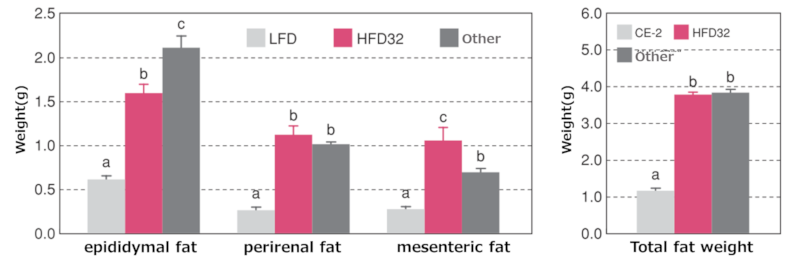
Weights of major organs and adipose tissue
Values in the table represent the mean ± standard error. Statistical analysis was performed between groups, and different symbols indicate significant differences (p < 0.05).



